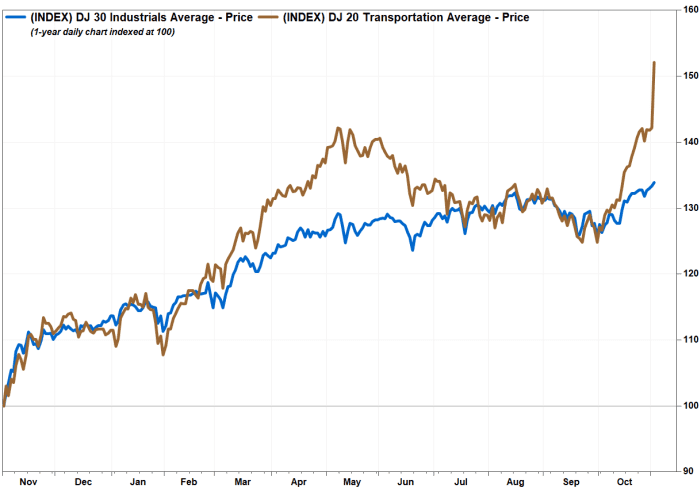This post was originally published on this site
There’s one thing more bullish than the Dow Jones Industrial Average rising to a record close — the Dow Jones Transportation Average reaching a record at the same time.
That’s according to the Dow Theory of market analysis, which has remained relevant to Wall Street investors for more than a century.
And while it might look like there is something wrong with the market pricing platform being used, because it’s showing the Dow transports
DJT,
up more than 1,000 points at a record high, that gain is real, mostly because of Avis Budget Group Inc.’s
CAR,
skyrocketing stock.
The Dow transports was up 1,083 points, or 6.8%, in afternoon trading Tuesday to blow past the previous record close of 15,943.30. In addition, the Dow industrials rallied 149 points, or 0.4%. That put the two indexes on track to set record closes on the same day, for the first time since May 7. See Market Snapshot.
The reason the Dow transports is up so much, with less than half (8) of its 20 components gaining ground, is because it’s a price-weighted index, just like the Dow industrials, and because component Avis Budget’s stock is seeing a rather unusual rally.
Avis stock shot up $186.43, or 108.7%, as the car rental company reported blowout third-quarter results, following a sharp increase in bearish bets as the stock spiked higher ahead of the results. The stock’s price gain would actually add roughly 1,137 points to the Dow transports’ price.
Don’t miss: Avis Budget’s ‘unnatural’ stock surge has options traders prepped for a volatile earnings reaction.
In fact, the Dow transports was actually up as much as 2,303 points, or 14.4%, at its intraday high of 18,246.51, while Avis’ stock was up $373.65, or 217.9%, at its intraday high of $545.11.
Now back to the Dow Theory.
One of the six basic tenets of the Dow Theory, which has been described by many as the oldest stock-market timing system that is still widely used, is that no important bull or bear market signal could be triggered unless both the Dow industrials and Dow transports flashed the same signal. Although the signals didn’t have to flash simultaneously, the less time that occurred between the signals, the stronger the signal.
The theory was based on the assumption that industrial and transport companies enjoyed symbiotic relationships, as transports take, and deliver, what industrials make. Although the Dow industrials no longer just includes makers, and the Dow transports includes others than takers, they still represent broader sectors that should be in sync if the economy and the stock market were in sync.
Don’t miss: Don’t dis the Dow Theory just because it’s over 100 years old.

FactSet, MarketWatch
Manuel Blay, co-editor for “TheDowTheory.com,” said under the classic definition of the Dow Theory, a buy signal was first triggered back in May 2020. But the Dow transports breaking out to a new high on Tuesday is still a “bullish indication,” and it means the “bull market is reaffirmed.”
For those questioning how accurate the Dow Theory could be, after more than 100 years in practice, Blay said the average annual gain for the indicator would have been 11.22% since 1953, compared with a 10.8% gain with a buy-and-hold strategy.
Dow transports keep on takin’
The Dow industrials’ climb above 36,000 has certainly been impressive. It rose 5.8% in October, the biggest monthly gain since March, . It is headed for a third-straight record close, and sixth record in the past eight sessions. Read more about the Dow’s 36,000 threshold.
But the Dow transports has been on fire, even before Tuesday’s record rally. It shot up 13.6% in October, the best one-month performance October 2011. And with Tuesday’s rally, the index was headed for its 12 gain in 14 sessions.
The Dow transports have run up 31.1% so far this year, with 19 of 20 components showing a year-to-date gain, while the Dow industrials have rallied 17.8% with 24 of 30 components up this year.




